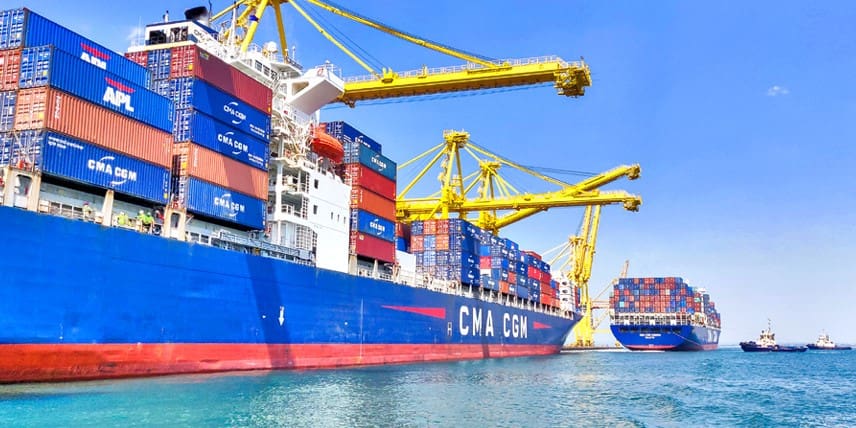
Ships at Port Botany
A REPORT into New South Wales’ freight network has recommended the NSW Government prioritise investment in boosting container capacity at Port Botany rather than support expansion plans from other ports vying for a share of the container freight task.
Released on June 6, the report, titled Delivering Freight Policy Reform in NSW, argued that Botany had the capacity to solely handle container flows for at least another 20 years.
However, it also noted that any moves to build container infrastructure at Port of Newcastle or Port Kembla should not be hindered by the NSW Government.
The report is a culmination of a more than two-year process aimed at developing a comprehensive strategic reform agenda and action plan to optimise freight transport in NSW.
In early 2024, the NSW Minister for Transport appointed an independent panel to undertake the work, led by Inland Rail review author Kerry Schott with Australian Logistics Council chief executive Hermione Parsons, and Lucio Di Bartolomeo, chair of Health Infrastructure NSW and Australian Naval Infrastructure.
Many lobby groups, including NSW Farmers, have pushed for container trade to open up at the Port of Newcastle as an alternative to Port Botany.
In May 2024, Port of Newcastle paid the NSW Government compensation to extinguish any liability under its Port Commitment Deed, which removes a key impediment to further expansion of containerised trade at the port.
In the report, the authors considered the potential opportunities from this regulatory change, but ultimately favoured Port Botany to continue as the primary container port for the coming decades.
Approximately 11 percent of the NSW grain crop is exported in containers and about 90pc of regional export containers moved to Port Botany from storage and terminals in regional NSW is moved by rail.
Currently Port Botany handles around 99.6pc of containerised imports.
“Port Botany will remain the key container port for NSW as it has significant potential capacity remaining for at least two decades and is close to the main import destinations in Sydney,” the report said.
The panel also recommended that the government “not determine the location of a second container terminal”, contrary to current policy which had identified Port Kembla as the location of a second container terminal when required.
Port Kembla is operated by the same organisation as Port of Botany, NSW Ports.
“Instead, the ports may develop and diversify as they see fit for their commercial purposes, as long as it does not require supporting infrastructure investment by the government in the near future, other than what is required at Port Botany.
“The uncertain future of the Port of Newcastle, the world’s largest coal terminal, justifies the port’s plans for diversification and expanding into container trade and other opportunities.
“The panel considers this is an appropriate commercial approach.”
The report urged the government to invest in any additional infrastructure requirements to support the container terminal capacity at Port Botany as a priority “as this is where the greatest and most strategic opportunity lies for NSW”.

Lucio Di Bartolomeo
The panel addressed expanded on its views on NSW’s container trade future during an information session held after the release of the draft findings of the report on October 2.
Mr Di Bartolomeo said given the Sydney metropolitan area was the destination of most of the state’s container imports, it was commonsense that exports would also flow from the closest port.
“Quite clearly imports into NSW are primarily aimed for the Sydney metropolitan area and hence Port Botany is by far the best port to achieve that, and we should be doing all necessary to ensure that Port Botany is utilised to its maximum,” Mr Di Bartolomeo said.
He said the current information was that Botany was handling 2.6 million TEUs annually and had the capacity to expand up to 7M TEUs.
“We don’t see 7 million TEUs being hit for at least 40 years.
“Our view is that at some point we may have to go to those other ports but let’s maximise the opportunity to use Port Botany.”
Industry views
The panel recommendations were supported by NSW Ports, but drew some criticism from Port of Newcastle as well as NSW Farmers.
Other stakeholders, such as agricultural merchandiser AMPS Agribusiness, also expressed concerns about the future of Botany during an earlier consultation phase.
While welcoming the presumption of Kembla as the next container port, in its submission to the draft report, Port of Newcastle urged the panel to go further to promote competition between ports.
“The removal of a presumption in favour of Port Kembla is indeed necessary, but it is not sufficient to ensure the most efficient outcomes for NSW’s freight network,” the submission said.
“There is a risk that without proactive measures to facilitate competition, the status quo may persist, potentially missing opportunities for innovation and cost reduction in the containerised freight sector.”
NSW Farmers submitted that the draft findings failed to adequately address the potential “to move greater volumes of bulk grain and containerised freight through both the Port of Newcastle and Port Kembla”.
They called for more investment “to support future bulk and containerised freight through ports other than Port Botany”.
In a submission to panel’s issues paper published in April last year, AMPS Agribusiness said its costs had been “driven up by the inefficiencies in the freight network and the congestion at Port Botany”.
“Port Botany is largely avoided by almost all of our major suppliers as a result,” the submission said.
AMPS said much of the product it sells travels via alternative ports, like Melbourne or Brisbane, to bypass Botany, “resulting in increased costs, a larger carbon footprint and logistical inefficiencies”.
“The current freight and port policy does not recognise the Port of Newcastle as a priority container terminal.
“If it was recognised, it would alleviate these issues, providing a more direct, lower carbon and cost-effective route for our agricultural products.”
Grain Central: Get our free news straight to your inbox – Click here

HAVE YOUR SAY